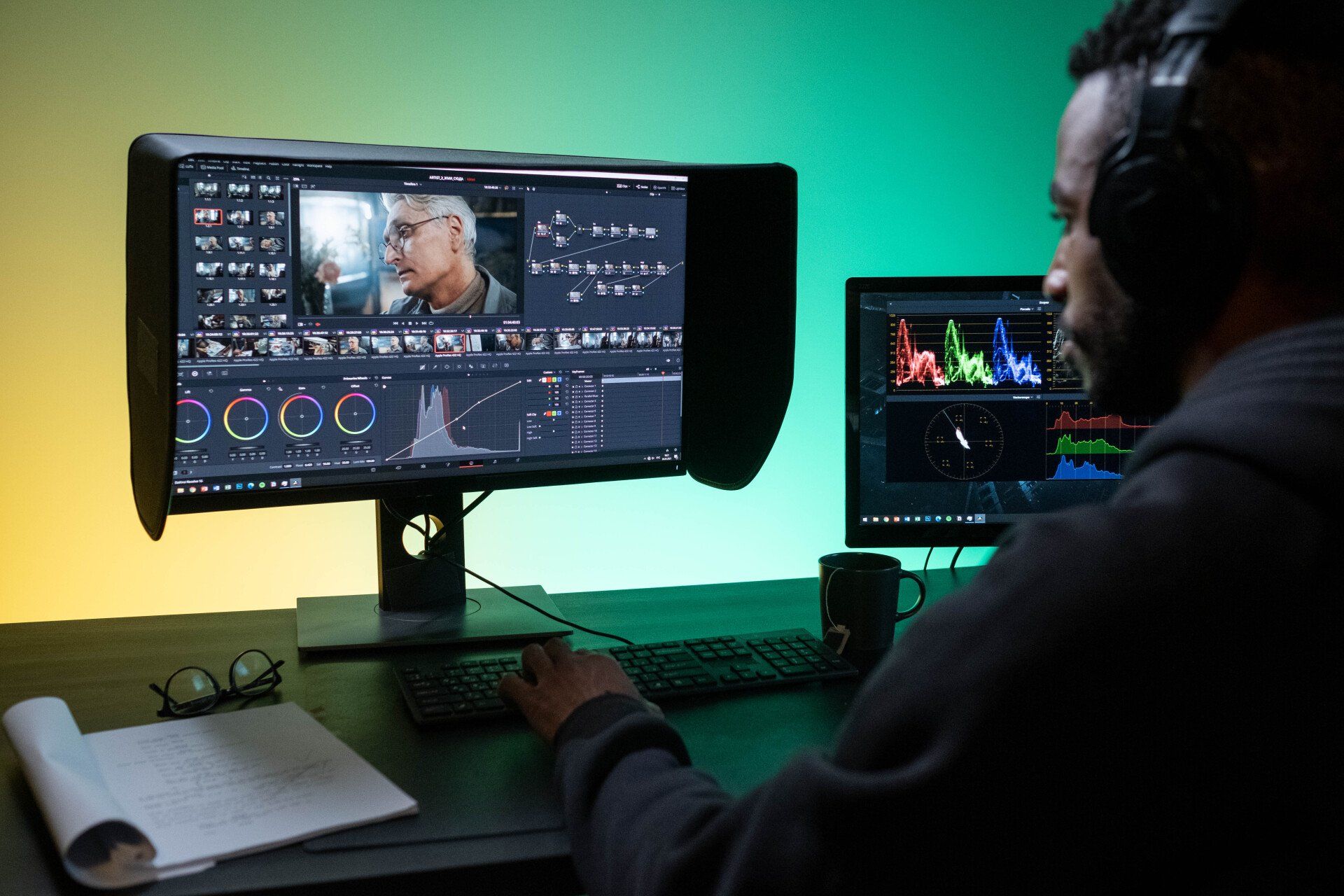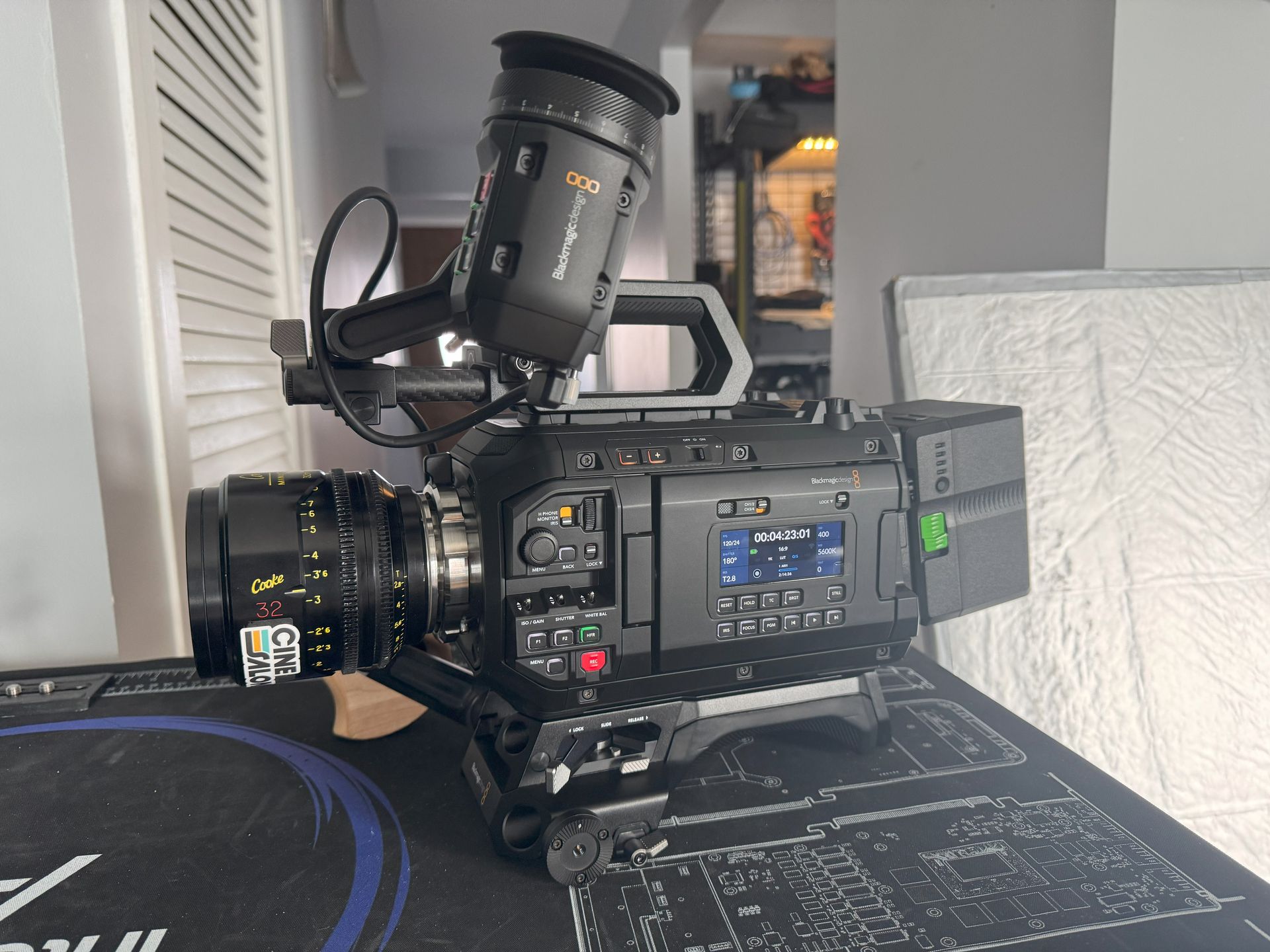
When creating engaging and impactful video content, a solid understanding of the stages of video production is critical. The video production process is typically divided into 6 main stages. Idea development, Pre-production, Production, Post-production, and Distribution. Each stage plays a crucial role in determining the overall success of a video project.
This comprehensive guide will delve deep into the different stages of video production. We will start from the Idea development stage. It will detail how it sets the stage for a seamless and efficient production process.
This stage is the foundation upon which the entire video project is built. This section will explore the idea development stage.
6 Stages of Video Production
- Idea development
- Pre-production
- Production
- Post-production
- Distribution
- The Evaluation and Feedback Stage
1. The Idea Development Stage: Laying the Groundwork
The idea development stage is the first step in video production. It involves brainstorming, refining, and solidifying the concept that will drive the entire video project. This stage is essential for establishing a solid foundation. It sets the direction for the subsequent stages. Let's look at the critical elements of the idea development stage:
1. Brainstorming Ideas
The idea development stage begins with brainstorming. This process involves generating a variety of ideas and exploring different concepts. It's essential to keep an open mind and consider various perspectives during this stage. The goal is to develop a creative and engaging idea that will resonate with the target audience.
2. Refining the Concept
Once various ideas have been generated, the next step is to refine the concept. This involves evaluating each statement based on originality, feasibility, and potential impact. The team should consider the target audience. Pay close attention to budget, and timeline when refining the idea. The goal is to select the concept that best aligns with the project's objectives. The part that has the most significant potential for success.
3. Developing the Story
With the concept selected, the next step is to develop the story. This involves fleshing out the narrative, characters, and setting. The story should be engaging to the audience. It's vital to balance creative storytelling and clear communication during this stage.
4. Creating a Treatment or Outline
After the story has been developed, creating a treatment or outline is essential. This document provides a detailed overview of the concept, story, and visual approach. It serves as a blueprint for the subsequent stages of video production. It helps to ensure everyone involved in the project understands the creative vision.
5. Pitching the Idea
The final step in the idea development stage is pitching the idea to stakeholders. This may include clients, investors, or collaborators. The pitch should communicate the concept, story, and visual approach. It should highlight the potential impact and value of the project. A successful pitch will secure the necessary support and resources for the video project to move forward.
The idea development stage is a critical part of the stages of video production. It sets the foundation for the project, establishing the creative vision and direction.

2. Pre-Production: Laying the Foundation for Success
The first stage of video production, pre-production, is arguably the most critical phase. The groundwork for the entire project is laid during pre-production. This stage sets the stage for a smooth production and post-production process. Some of the key elements involved in pre-production include:
1. Concept Development
The first step in the pre-production stage is to develop a strong concept for the video project. This involves brainstorming ideas, identifying the purpose and goals of the video. You also define the target audience at this stage. The idea should be engaging and relevant to the audience while conveying the intended message.
2. Scriptwriting
Once the concept is defined, the next step is creating a script for the video. The script serves as a blueprint for the production process. It outlines the dialogue, visuals, and audio elements. A well-written script ensures the story flows and the video communicates its message.
3. Storyboarding
A storyboard visually represents the script, usually in sketches or images. It helps the production team visualize the flow of the video. They identify potential issues and plan camera angles and shot sequences. Storyboarding is a crucial aspect of pre-production. It helps to ensure that the tape stays true to the creative vision.
4. Casting and Location Scouting
Casting is the process of selecting the actors or subjects who will appear in the video. This involves holding auditions, reviewing portfolios, and negotiating contracts. It is essential to choose the right talent, as their performance can significantly impact the video's success.
Location scouting involves identifying and securing the places where the video will be filmed. This requires considering lighting, sound, accessibility, and permits. Choosing the right location is vital to creating a believable and engaging visual backdrop for the video.
5. Assembling the Production Team
A successful video project requires a talented and experienced production team. The pre-production stage involves hiring or assigning roles such as the director and producer. Including the cinematographer, editor, and any extra crew members required for the project. Ensuring that the team is skilled is essential to achieving the desired results.
6. Budgeting and Scheduling
Budgeting involves estimating the costs associated with the video project and allocating resources. This includes expenses like equipment rental, talent fees, location permits, and post-production services. Creating a detailed and realistic budget is crucial for ensuring that the project stays on track. Funding is essential for ensuring that the project stays on track. It helps the team avoid exceeding financial constraints.
Scheduling, on the other hand, involves creating a timeline for the project. It involves detailing the dates and times specific tasks and milestones should be completed. This includes pre-production activities, shooting days, and post-production deadlines. A well-organized schedule helps ensure the project stays on track.
7. Equipment Selection and Preparation
Selecting the appropriate equipment for the video project is another vital aspect of the pre-production stage. This involves determining the type of cameras, lenses, and lighting. Sound and other gear are also required to achieve the desired visual and audio effects. The equipment should be tested and prepared before production begins. This is to ensure it functions correctly and avoid delays or issues during the shoot.
8. Rehearsals and Table Reads
Rehearsals and table reads are essential to ensure the talent is well-prepared for the shoot. During rehearsals, actors practice their lines, block, and interact with other cast members. This helps refine their performances and identify any issues. Addressing any issue before filming begins is essential.
Table reads, on the other hand, involve the entire cast and crew coming together to read through the script aloud. This allows everyone to understand the story and their roles. It reveals how the scenes will flow together. It also allows the director and producer to address questions or concerns during the reading.
In conclusion, the pre-production stage is the foundation upon which the success of a video project rests. This crucial first phase of video production involves careful planning and preparation. From concept development and scriptwriting to casting, location scouting, budgeting, and scheduling.
Epic Pre - Production Tricks You Should Know
Here are five lesser-known tricks producers use during the video pre-production stage:
- Storyboard Sketches: Producers create rough, hand-drawn sketches to visualize the sequence of shots. This helps streamline the production process and identify potential issues early on.
- Color Scripts: A color script is a visual guide that maps out the colors and moods of each scene. Color scripts help create consistency in lighting and tone throughout the video.
- Mood Boards: Producers use mood boards to gather inspiration for the video's visual elements, such as wardrobe, props, and locations. It helps the team stay on track and maintain a unified vision.
- Script Read-Throughs: The team conducts multiple script read-throughs to identify potential issues and make necessary changes before filming. This saves time and resources during production.
- Location Scouting: Producers scout and secure locations before filming to ensure that the chosen sites meet the video's requirements, such as access, lighting, and acoustics. It helps avoid last-minute changes and delays.

3. The Production Stage: A Comprehensive Guide
The stages of video production are essential to grasp for anyone looking to create successful video content. As discussed in the previous guide, pre-production is the first stage. It sets the groundwork for a successful project. Now, we will delve into the second stage of the stages of video production – production.
This stage involves the actual filming or recording of the video content. In this guide, we will explore the critical elements of the production stage w
This guide will focus on the production stage, where the creative vision comes to life.
The Production Stage: Bringing the Vision to Life
The second stage of the stages of video production is the actual filming of the video content. The production team captures the visuals and audio during this stage to make up the final video. Let's look at the critical elements involved in the production stage:
1. Setting Up the Location
Before the cameras start rolling, the production team must set up the location. This involves arranging the set, props, and lighting to create the desired visual environment. The team also ensures that the site is safe and free of any hazards.
2. Camera and Lighting
During the production stage, the cinematographer and camera operators work together to capture the visuals. They choose the right camera angles, lenses, and movements to tell the story effectively. Proper lighting is also crucial to create the right mood and atmosphere.
3. Sound Recording
Capturing high-quality audio is vital in the stages of video production. The sound team, including the sound mixer and boom operator, records the dialogue. They also record other audio elements. They use microphones and other audio equipment to ensure clear and crisp sound.
4. Directing the Talent
The director plays a vital role in the production stage. They guide the talent, ensuring they deliver the right emotions. The director works closely with the actors and the rest of the production team. They help to bring the creative vision to life.
5. Staying on Schedule
During the production stage, it's crucial to stay on schedule. The production team must capture all the necessary footage within the allotted time. This requires clear communication and organization from everyone involved.
6. Continuity and Coverage
The production team must monitor continuity to ensure the final video flows. This ensures that each scene's visual and audio elements match seamlessly. The team must also capture enough coverage, filming multiple angles and takes of each scene. This allows for flexibility during the editing process.
7. Monitoring Progress
The director, producer, and other key team members throughout the production stage must monitor progress. They review the footage and audio to ensure everything is on track. They must be aligned with the creative vision. If any issues arise, the team must address them quickly to keep the project moving forward.
The production stage is an exciting and crucial part of the stages of video production. This is when the creative vision comes to life, and the story unfolds on camera. By understanding the critical elements involved in the production stage and working together as a team, the production crew can create a captivating and engaging video that effectively conveys the intended message.
The production stage is a critical part of the stages of video production, where the video content is filmed or recorded. By following the guidelines and paying attention to the essential elements outlined in this comprehensive guide, you can ensure a smooth and efficient production process.
This, in turn, sets the stage for a successful post-production process. This is where the raw footage and audio are edited and polished to create the final video.
5 Epic Video Production Tricks You Should Know
5 Essential Video Production Tricks You Need to Know:
- Master the J-Cut Technique: The J-cut is a vital trick where audio from the upcoming scene begins before the visual transition. This technique guides the viewer smoothly through scene changes, fostering a natural and seamless flow.
- Leverage the Power of Match Cuts: Connecting two scenes by matching their elements (action, sound, or color) is a powerful way to create smooth transitions. By using match cuts, you maintain visual continuity and enhance the storytelling experience.
- Apply the 30-Degree Rule Religiously: To keep your audience engaged, change the camera angle by at least 30 degrees between shots featuring the same subject. This crucial rule helps you avoid jarring jump cuts and maintains the viewer's interest.
- Utilize L-Cut Techniques for Seamless Connections: L-cuts, where audio from the previous scene continues into the following scene, are essential for creating smooth connections between scenes. This technique boosts storytelling by providing a seamless narrative experience.
- Transform Your Footage with Color Grading: Color grading is the key to elevating your video's visual appeal. By adjusting colors, contrast, and saturation, you set the mood, unify shots, and create an immersive visual experience for your audience.

4. The Post-Production Stage: A Comprehensive Guide
In video creation, understanding the stages of video production is crucial. It is important for anyone looking to create engaging and successful video content. As we've discussed in previous guides, the first two stages are pre-production. Those stages involve planning and preparation, and production. That is actually where the actual filming takes place. In this section, we will explore the final stage of the stages of video production.
This stage involves editing and polishing the raw footage to create the finished video product. This guide will focus on the post-production stage. This is where the raw footage is transformed into the final video product.
The Post-Production Stage: Crafting the Final Video
The third and final stage of the stages of video production is post-production. This stage involves taking the raw footage and audio captured and turning it into video. The type that effectively communicates the intended message. Let's explore the critical elements involved in the post-production stage:
1. Organizing and Reviewing Footage
The first step in post-production is organizing and reviewing the raw footage. The editor must sort through the shots, takes, and audio recordings. This helps determine which elements that will be used in the video. This involves careful review and selection. Ensure that the best footage is chosen to tell the story effectively.
2. Editing the Video
Once the footage has been organized, the editor assembles the video. This involves arranging the shots and trimming and cutting the footage as needed. It also includes fine-tuning the timing and pacing of the video. The editor must understand the creative vision and the stages of video production. They must ensure that the final video effectively communicates the intended message.
3. Adding Transitions and Effects
During the post-production stage, the editor also adds transitions and effects. This is to enhance the visual and audio elements of the video. Transitions smooth the flow between shots. Effects can create visual or audio enhancements, such as color correction, sound effects, or special effects. These elements should be used to support the story and the creative vision.
4. Sound Design and Mixing
Sound design is an integral part of the post-production stage of the stages of video production. This involves editing and enhancing the audio elements. Elements such as dialogue, music, and sound effects. They are used create a balanced and engaging soundscape. Sound mixing consists of adjusting the levels and placement of the various audio elements. This is to ensure they blend and support the visuals.
5. Adding Music and Voiceovers
Music and voiceovers can be essential elements in a video. It helps to set the tone and convey information. During the post-production stage, the editor adds these elements to the video. They complement the visuals and effectively communicate the intended message.
6. Color Grading and Correction
Color grading and correction are essential for creating an appealing and consistent video. During post-production, the editor adjusts the footage's colors and tones. Add contrast to achieve the desired visual aesthetic. This process helps to enhance the overall look and feel of the video. It ensures that it aligns with the creative vision.
7. Quality Control and Final Review
Before the video is complete, it must undergo thorough quality control. This gives room for the review process. This involves checking for technical issues. such as editing or sound errors, and ensuring that the video effectively communicates the intended message and adheres to the creative vision.
The editor, director, producer, and other key members of the production team collaborate during this process to identify and address any issues or areas for improvement. This step is crucial in the post-production stages of video production to ensure a high-quality final product.
8. Exporting and Delivery
Once the video has passed the quality control and final review process, it is ready for exporting and delivery. Depending on the intended distribution platform and audience, the editor exports the last video in the appropriate format and resolution.
The video may need to be compressed or converted to different formats to suit various platforms or devices. The final video is then delivered to the client or distributed according to the agreed-upon plan.
The post-production stage is a critical part of the stages of video production, where the raw footage and audio captured during production are transformed into a polished and engaging final video. By understanding the critical elements involved in the post-production process and working together as a team, the production crew can create a high-quality video that effectively conveys the intended message and resonates with the target audience.

5 Epic Post-Production Tips You Should Know
5 Lesser-Known Post-Production Tricks for Video Producers
- J-Cut and L-Cut: J-Cut involves starting the audio from the next scene before the visuals appear, while L-Cut has the audio continue after the visuals change. These create a seamless flow between scenes and hold viewers' interest.
- Speed Ramping: Alter the speed of footage to create dynamic and engaging visuals. Slow down for dramatic effect or speed up for a sense of urgency.
- Sound Design Layers: Enhance the video by layering sounds. Combine dialogue, music, and sound effects to create an immersive audio experience.
- Match Cuts: Connect different shots by matching the action or subject in each scene. This creates a smooth transition and helps tell a cohesive story.
- Color Grading: Boost the visual appeal by adjusting colors, contrast, and brightness. This enhances the mood and atmosphere of the video.

The Distribution Stage: A Comprehensive Guide
As we have covered in previous tutorials, the three primary phases are pre-production, production, and post-production. However, distribution, the fourth stage, is frequently missed while being as significant. Sharing the finished video with the intended audience is part of this phase. In this in-depth guide, we will cover the distribution stage in detail.
5. The Distribution Stage: Reaching the Audience
The final stage of the stages of video production is distribution. This stage is crucial, without proper distribution, even the most well-crafted video will fail to reach its intended audience and achieve its goals. Let's explore the critical elements involved in the distribution stage:
1. Identifying the Target Audience
Before distributing the video, it's essential to know the target audience. This involves understanding their demographics, preferences, and viewing habits. The video should be tailored to this audience. Ensure it appeals to them and effectively communicates the intended message.
2. Choosing the Right Platforms
There are numerous sites for sharing video material. Picking the best ones is essential for effective dissemination. The target demographic, the type of video, and the targeted reach are things to consider when choosing a platform. Social media, websites, video-sharing services, television, and film festivals are common platforms.
3. Optimizing the Video for Each Platform
Each platform has its requirements and best practices for video content. When distributing the video, optimizing it for each platform is essential. This may involve adjusting the format, resolution, or compression settings. It creates platform-specific versions of the video. Versions such as vertical video for social media stories.
4. Creating a Distribution Strategy
A well-planned distribution strategy is essential for reaching the target audience effectively. This involves setting goals. It involves identifying the best platforms and planning a video release timeline. A successful distribution strategy also includes promotion and marketing efforts. It helps build awareness and anticipation for the video.
5. Promoting the Video
Video promotion is an essential part of the distribution stage of video production. This can involve a combination of organic and paid promotion. This could include social media posts, email campaigns, and search engine optimization (SEO). Advertising is an integral part of it. The goal is to create buzz around the video and drive viewership.
6. Measuring Success
Once the video has been distributed, measuring its success is essential. This involves tracking various metrics, such as views, engagement, and conversion rates. Analyzing these metrics can provide valuable insights into the effectiveness of the video. The distribution strategy, allowing for adjustments and improvements in future projects.
Epic Hacks in Video Distribution You Should Know
While there might not be any "unknown" hacks, as the video production industry is quite vast, there are certainly lesser-known or underutilized tips and tricks to enhance the distribution stage of video production. Here are some of them:
- Optimize for different platforms: Each platform has its own set of requirements and best practices. Optimize your video by adjusting the aspect ratio and resolution. Arrange the format to suit the platform you are distributing it on (e.g., YouTube, Facebook, Instagram, Twitter, LinkedIn, etc.).
- Utilize SEO: Use video metadata like titles, descriptions, and tags to make your content easily discoverable by search engines. Research relevant keywords and integrate them into the metadata to improve your video's ranking on search results.
- Create platform-specific thumbnails: Design eye-catching, customized thumbnails for each platform you're distributing your video on. Thumbnails should be high-resolution, properly sized, and have a clear, engaging visual to entice viewers to click on your video.
- Leverage subtitles and captions: Subtitles and captions not only make your videos more accessible to a wider audience but also increase watch time, as many users watch videos with the sound off. Create accurate, properly timed captions for your videos, and make sure they are optimized for each platform.
- Engage with your audience: Actively engage with your audience by responding to comments, questions, and feedback on your videos. Building a community around your content can lead to increased visibility, better engagement, and higher chances of your content being shared.
- Schedule and cross-promote: Plan your video releases strategically, and use social media platforms to cross-promote your content. Schedule your video releases during peak engagement times for the platforms you're using, and tease upcoming content to build anticipation.
- Collaborate with influencers or other creators: Collaborate with other creators, influencers, or industry professionals to expand your reach and tap into new audiences. This can increase your video's visibility and engagement by exposing your content to their followers.
- Use end screens and annotations: Utilize end screens and annotations to direct viewers to related content, playlists, or calls-to-action (CTAs). This helps increase watch time and engagement, while also guiding viewers to explore more of your content.
- Track and analyze performance: Keep an eye on your video's performance metrics, such as views, watch time, audience retention, and engagement rates. Use this data to optimize your content strategy, identify what works best, and continually improve your video distribution efforts.
- A/B test your content: Test different aspects of your video content, such as thumbnails, titles, or descriptions, to see which performs better. Use this information to optimize your video distribution and maximize engagement.
By implementing these lesser-known tips and tricks, you can significantly improve the reach and engagement of your videos during the distribution stage of video production.
The distribution stage is a critical component of the stages of video production. Proper distribution ensures that the final video reaches its intended audience. By understanding the key elements involved in the distribution stage and following the guidelines outlined in this comprehensive guide, you can create a successful distribution strategy that maximizes the reach and effectiveness of your video content.
6. The Evaluation and Feedback Stage: Ongoing Improvement
Understanding the stages of video production is crucial for successful video content. While we've discussed idea development, pre-production, production, post-production, and distribution. However, there's an extra stage to consider – evaluation and feedback. This stage helps refine and enhance your video projects over time. This guide will explore the evaluation and feedback stage, keeping a Hemingway readability score of 6 for easy understanding.
The Evaluation and Feedback Stage: Constant Growth
The evaluation and feedback stage is continuous throughout video production and after distribution. It involves collecting and analyzing feedback to identify improvements and ensure your video projects evolve. Let's look at the key elements of the evaluation and feedback stage.
1. Internal Feedback
During the stages of video production, promote open communication. Collaboration among team members is essential. This allows everyone to share ideas, concerns, and suggestions. It leads to constant improvement and refinement of the video project. Review the work at each stage and provide constructive feedback. It helps identify improvement areas, ensuring the final product matches the creative vision.
2. Test Screenings
Test screenings help gather feedback during post-production. By showing the video to a small, representative sample of the target audience, you gain insights into the video's reception and identify areas needing refinement. Test screenings ensure the video effectively communicates the intended message.
3. Audience Feedback
After distributing the video, gather feedback from the broader audience through surveys. Use social media comments and direct communication with viewers. Analyzing audience feedback offers valuable insights into the video's strengths and weaknesses, informing future projects and helping create more engaging content.
4. Performance Metrics
In addition to feedback, track and analyze performance metrics, like views, engagement, and conversion rates. These metrics offer insights into the video and distribution strategy's effectiveness. Monitoring performance metrics helps identify trends and improvement areas, optimizing your video projects over time.
5. Iterative Improvement
The evaluation and feedback stage is an ongoing process informing all stages of video production. Continuously gathering feedback and analyzing performance metrics allows refining your approach and make data-driven decisions leading to better video content. This iterative improvement process ensures your video projects evolve and resonate with your target audience.
The evaluation and feedback stage is essential in video production, enabling continuous improvement and refinement of your video projects. You create more impactful and engaging video content by gathering feedback, analyzing performance metrics, and fostering open communication and collaboration. Remember, the stages of video production are interconnected, and mastering each step, including the evaluation and feedback stage, is vital for creating successful video content.

Top Video Production Companies: A Guide to the Best in the Industry
Creating captivating and impactful video content requires a strong understanding of the stages of video production and the right team to bring your vision to life. With countless video production companies available, finding the best one for your project can be a challenge. In this guide, we will highlight some of the top video production companies in the industry.
1. Framestore
Framestore is a world-renowned video production company that has made a name for itself by working on the high-profile film, advertising, and television projects. With expertise in all stages of video production, Framestore's talented team of professionals can handle everything from concept development to post-production and distribution.
They have worked on projects like "Doctor Strange" and "Guardians of the Galaxy" and collaborated with major brands like Google and BMW. Framestore's commitment to excellence and ability to create stunning visual content make them a top choice for any video project.
2. The Mill
The Mill is a globally recognized video production company with offices in London, New York, Los Angeles, and Chicago. Known for its cutting-edge approach to the stages of video production, The Mill has been creating exceptional content for over three decades.
They specialize in visual effects, creative content, and immersive experiences for clients like Nike, Audi, and Apple. With their award-winning portfolio and experienced team, The Mill has proven itself as a leader in the industry.
3. Wieden+Kennedy
Wieden+Kennedy is a full-service advertising agency with a strong focus on video production. Their expertise in the stages of video production has led to successful collaborations with global brands like Coca-Cola, Nike, and Procter & Gamble.
With offices in cities like Amsterdam, Tokyo, and New York, Wieden+Kennedy's diverse team can handle projects of any size and complexity. Their ability to create compelling narratives and visually stunning content has made them a top choice for clients worldwide.
4. Industrial Light & Magic (ILM)
Founded by George Lucas in 1975, Industrial Light & Magic (ILM) is a legendary video production company that has created some of the most iconic films in history. With a deep understanding of the stages of video production, ILM has worked on projects like "Star Wars," "Jurassic Park," and "Avengers: Endgame."
Their dedication to cutting-edge technology and unparalleled creativity has earned them numerous awards and solidified their place as one of the top video production companies in the world.
5. Blink Productions
Blink Productions is a London-based video production company specializing in commercials, branded content, and music videos. With a strong emphasis on the stages of video production, Blink's talented team of directors, producers, and editors have worked with clients such as Spotify, Amazon, and Adidas.
Their unique storytelling approach and visually striking content have made them a sought-after video production company.
6. Biscuit Filmworks
Biscuit Filmworks is an international video production company with a reputation for excellence in commercials, branded content, and digital media. Founded in 2000, Biscuit has worked with clients like Samsung, Ford, and Budweiser.
Their understanding of the stages of video production and their ability to bring innovative ideas to life has garnered them numerous awards and accolades.
With offices in Los Angeles, New York, and London, Biscuit Filmworks is well-positioned to handle projects of any size and complexity.
7. Partizan
Partizan is a global video production company known for its creative excellence and innovative approach to the stages of video production. With offices in London, Paris, New York, Los Angeles, and Berlin, Partizan's diverse team of professionals brings a wealth of experience to every project.
They have worked with clients like Levi's, Coca-Cola, and Honda and produced music videos for artists like Taylor Swift, U2, and Coldplay.
Partizan's expertise in the stages of video production has led to numerous awards and recognitions. They have been honored at prestigious events like the Cannes Lions, MTV Video Music Awards, and British Arrows. Partizan's commitment to pushing the boundaries of creativity and its technical prowess make them a top choice for clients seeking a unique and engaging visual experience.
Regarding the best video production companies, Framestore, The Mill, Wieden+Kennedy, Industrial Light & Magic, Blink Productions, Biscuit Filmworks, and Partizan stand out for their dedication to excellence, creativity, and innovation throughout the stages of video production.
Each company has a proven track record of producing unique content for clients across various industries and formats. By understanding the individual needs of their clients and leveraging their expertise in the stages of video production, these companies continue to set the standard for quality and impact in the world of video content.
As you consider your options for video production companies, remember that the best choice will depend on your project's specific requirements, budget, and creative vision. By researching and collaborating with a company that excels in the stages of video production and aligns with your goals, you can bring your vision to life and create captivating, memorable content that leaves a lasting impression on your audience.
Conclusion
A successful project must go through all five of the film production stages. Although some are easier than others, as you might have noticed, they all have their difficulties. Working diligently and thoroughly during one phase usually enables you to operate more smoothly during the subsequent phase. So, you shouldn't take Development or Pre-Production lightly.
This is because the lack of preparation will affect the rest of your project and force you to solve problems. It slows you from carrying out what you had initially planned and envisioned. Finally, remember that each stage is lovely in its way. As such, take time to savor and value each one. Have fun shooting.

Get total clarity on your video marketing and paid media with our FREE comprehensive data audit.







